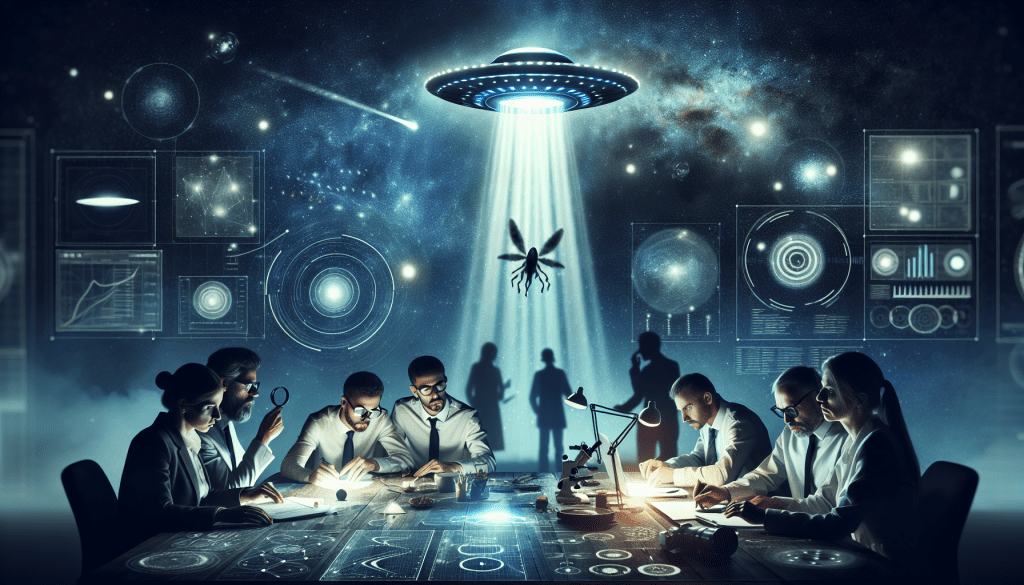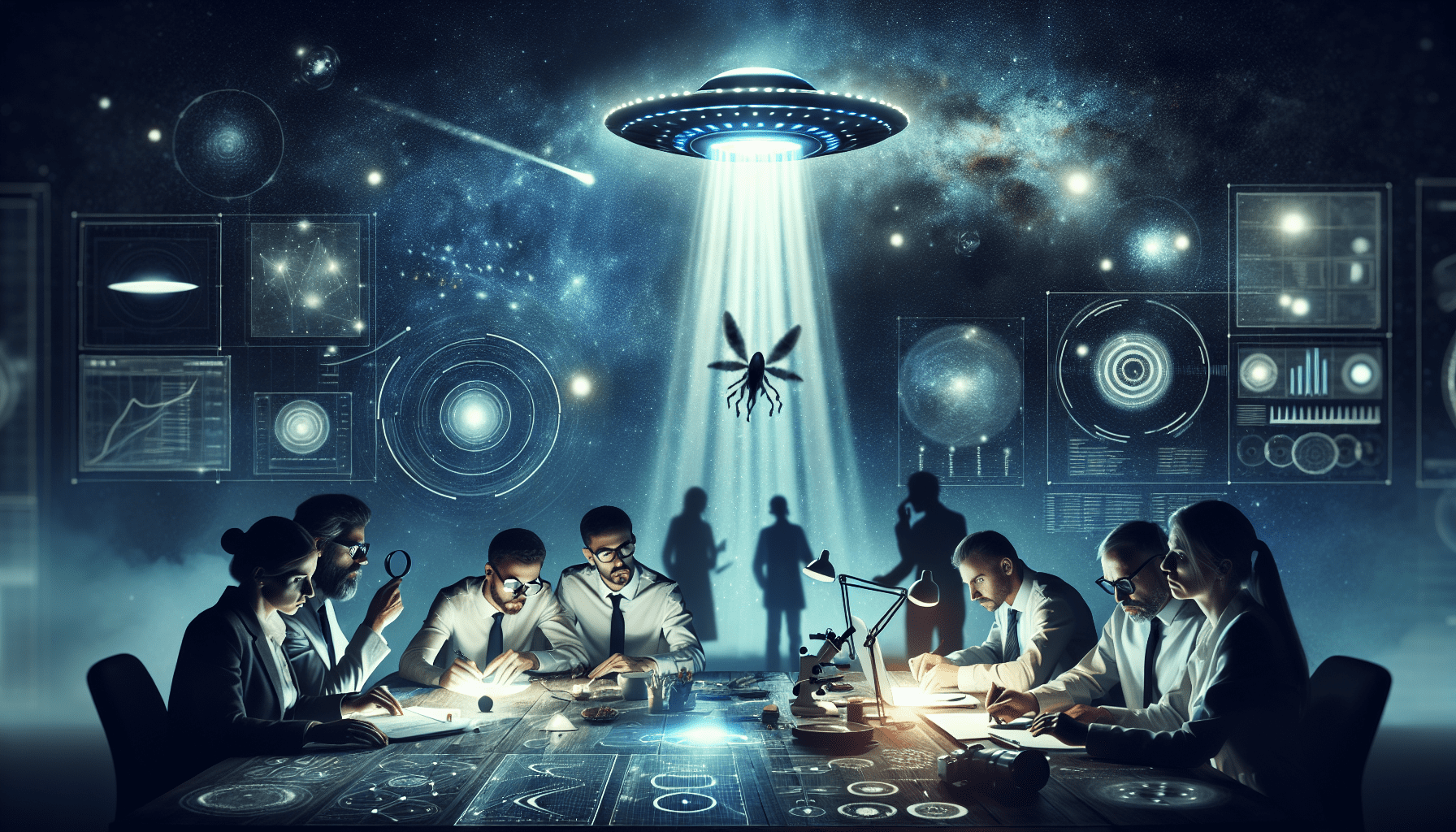Are you curious about the fascinating world of UFOs? In this article, we will explore the science behind UFO investigations. From eyewitness accounts to physical evidence, we will delve into the methods used by researchers and scientists to study these unidentified flying objects. Get ready to embark on a captivating journey as we uncover the secrets of the science of UFO investigation.

Understanding UFOs
UFOs, which stands for Unidentified Flying Objects, are often associated with extraterrestrial visitors from outer space. However, it is important to define what exactly constitutes a UFO. As the name suggests, a UFO refers to any object in the sky that cannot be easily identified by the observer. This could include a variety of phenomena, ranging from weather anomalies and astronomical events to experimental aircraft and other man-made objects. The key characteristic of a UFO is the uncertainty surrounding its nature and origin.
Defining UFOs
When it comes to defining UFOs, the term itself highlights the lack of information regarding what is being observed in the sky. UFOs can take different forms, such as disc-shaped objects, bright lights, or strange aerial movements. What sets them apart is the inability to identify them conclusively at the time of observation. It is this undefined quality that piques the interest of scientists, researchers, and enthusiasts alike.
Historical accounts of UFO sightings
Throughout history, numerous accounts of UFO sightings have been reported. Ancient civilizations, such as the Egyptians and Mayans, depicted peculiar objects in their artwork that resemble modern-day descriptions of UFOs. In more recent times, the infamous Roswell incident in 1947 sparked widespread interest in UFOs when an unidentified object crashed near Roswell, New Mexico. While the incident was later explained as a weather balloon, it fueled the belief that alien spacecraft were visiting Earth.
The mainstream perception of UFOs
Despite the longstanding fascination with UFOs, the mainstream perception of these unexplained aerial phenomena has often been met with skepticism and ridicule. Many times, UFO sightings are dismissed as misidentifications, hoaxes, or simply the result of overactive imaginations. This has created a stigma around the topic, making it difficult for serious researchers to gain credibility in the scientific community.
Challenges in studying UFOs
Studying UFOs presents several challenges for scientists and investigators. The sheer number of reported sightings makes it difficult to separate genuine unexplained phenomena from misidentifications or hoaxes. Additionally, the lack of consistent and verifiable evidence hinders scientific progress in understanding UFOs. The subjectiveness of eyewitness testimonies and the absence of concrete physical evidence pose significant obstacles in conducting rigorous scientific investigations.
Scientific Approaches to UFO Investigation
In order to understand UFOs from a scientific perspective, various approaches are taken to investigate these mysterious phenomena. Scientists employ methods such as data collection and analysis, eyewitness testimonies, radar and photographic evidence, examination of physical trace evidence, and analysis of government documents.
Data collection and analysis
One of the primary scientific methods used in UFO investigations is the collection and analysis of data. This involves gathering information about UFO sightings, including the date, time, location, and detailed descriptions provided by witnesses. By collecting and analyzing this data, patterns can potentially emerge, allowing researchers to identify trends or common characteristics associated with UFO sightings.
Eyewitness testimonies
Eyewitness testimonies play a crucial role in UFO investigations. Although subjective, these accounts provide valuable firsthand information that can help corroborate or challenge the existence of UFOs. Scientists and investigators carefully evaluate the credibility and reliability of eyewitness accounts through interviews, questionnaires, and psychological assessments. Multiple eyewitness testimonies that align with each other can lend support to the validity of a UFO sighting.
Radar and photographic evidence
Radar and photographic evidence are often considered more objective forms of documentation in UFO investigations. Radar data can track the movement of unidentified objects in the sky, capturing their speed, altitude, and trajectory. Likewise, photographs and videos taken by witnesses can offer visual evidence of UFO sightings. However, it is imperative to thoroughly analyze these forms of evidence to rule out any possible misinterpretation or manipulation.
Physical trace evidence
In some cases, UFO sightings leave behind physical trace evidence that can be scientifically analyzed. This could include soil or vegetation samples taken from the landing sites, electromagnetic anomalies, or traces of radiation. By examining these physical remnants, researchers aim to uncover clues about the nature and origin of UFOs. However, the rarity of such physical evidence makes it difficult to draw definitive conclusions.
Analysis of government documents
In recent years, there has been an increased push for the release of classified government documents related to UFO sightings and investigations. Analyzing these documents can provide valuable insight into the government’s perspective on UFOs and any past efforts made to investigate them. Researchers scrutinize declassified files for any patterns or inconsistencies that might shed light on the phenomenon.
Extraterrestrial Hypotheses
Extraterrestrial hypotheses explore the possibility that UFOs are indicative of intelligent life from other planets or galaxies. While these hypotheses capture the imaginations of many, they require critical examination within the scientific community to consider their plausibility.
Extraterrestrial life possibilities
The existence of extraterrestrial life has long intrigued scientists and the public alike. With billions of galaxies containing countless stars and planets, the probability of other intelligent civilizations in the universe seems statistically probable. UFO sightings, if indeed of extraterrestrial origin, could offer tantalizing evidence supporting the notion that we are not alone.
The Drake Equation
The Drake Equation, formulated by astrophysicist Frank Drake, aims to estimate the number of technologically advanced civilizations that could exist in our galaxy. By factoring in variables such as the number of habitable planets and the likelihood of life evolving on them, the equation provides a framework for understanding the potential abundance of extraterrestrial life.
Fermi Paradox
The Fermi Paradox poses the question, “If extraterrestrial civilizations are abundant, why haven’t we detected any clear signs of their existence?” This paradox highlights the apparent contradiction between the high probability of intelligent alien life and the lack of concrete evidence or contact with extraterrestrial beings.
Probing the likelihood of intelligent life
While the possibilities of intelligent alien life and their potential visits to Earth are intriguing, it is essential to approach these hypotheses with scientific rigor. Researchers must assess the probability of intelligent life evolving independently elsewhere in the universe, considering the various factors that influence the development of complex organisms.
Interstellar travel capabilities
A vital aspect of the extraterrestrial hypothesis is the examination of whether advanced civilizations possess the technological capabilities for interstellar travel. The immense distances between stars and galaxies present significant challenges for space travel. Scientists explore theoretical concepts such as warp drives, wormholes, and other hypothetical propulsion systems to assess the feasibility of interstellar journeys.
Psychological and Sociological Perspectives
While extraterrestrial hypotheses address the potential reality of UFOs, psychological and sociological perspectives delve into the human aspects of UFO sightings and beliefs.
Psychological explanations for UFO sightings
Psychologists have studied the psychological phenomena that contribute to UFO sightings and experiences. Pareidolia, for example, is a phenomenon in which the brain seeks recognizable patterns in random or ambiguous stimuli. This tendency can lead individuals to mistake natural or man-made objects for UFOs due to misperceptions or cognitive biases.
Cultural and societal influences on UFO beliefs
Cultural and societal influences play a significant role in shaping beliefs about UFOs. Throughout history, various cultural, religious, and mythological beliefs have interwoven with UFO narratives. Societal factors, such as media portrayals and collective beliefs, can impact the interpretation and acceptance of UFO sightings and encounters.
Mass hysteria and collective delusions
Mass hysteria and collective delusions can contribute to the widespread belief in UFO sightings. When a group of people collectively believe in the existence of UFOs or share similar encounter experiences, it can reinforce and amplify the belief, even in the absence of concrete evidence. The power of suggestion and the desire for shared experiences can lead to an amplification of UFO beliefs within a community.
Implications for the study of human behavior
Psychological and sociological perspectives on UFOs have significant implications for the study of human behavior. Explaining why individuals believe in UFOs or have UFO experiences provides insights into the workings of the human mind and the influence of culture and society on our perceptions. Understanding these dynamics can shed light on broader issues of belief formation and the impact of collective ideas on society.
Government Involvement and UFO Investigations
Government involvement in UFO investigations has been a source of intrigue and speculation. From historical initiatives to declassified documents, the role of governments in understanding UFOs has captured the attention of researchers and enthusiasts.
Historical government initiatives on UFOs
Various governments around the world have undertaken initiatives to investigate UFO sightings. One notable example is the United States Air Force’s Project Blue Book, which operated from 1952 to 1969. The project collected and analyzed thousands of UFO reports in an attempt to determine their nature and potential threat level.
Declassified documents related to UFOs
In recent years, governments have declassified numerous documents related to UFO sightings and investigations. These documents offer insights into official government responses, strategies, and assessments of UFO reports. Researchers meticulously analyze these documents to gain a deeper understanding of government attitudes and actions concerning UFOs.
Conspiracy theories and government cover-ups
The relationship between governments and UFOs has given rise to numerous conspiracy theories. Some believe that governments possess classified information regarding extraterrestrial encounters and are actively covering up the truth. While such conspiracy theories lack concrete evidence, they reflect a deep-seated mistrust in official narratives and a desire for greater transparency.
Scientific committees and investigations
In addition to government initiatives, scientific committees and organizations have also engaged in UFO investigations. These committees bring together experts from various scientific disciplines to evaluate the available evidence, conduct rigorous scientific analyses, and provide objective assessments of UFO sightings. Their involvement helps bridge the gap between governmental actions and scientific exploration.
UFO Hoaxes and Misidentifications
The study of UFOs is not without its share of hoaxes and misidentifications. Distinguishing between genuine sightings and deliberate deception is crucial in maintaining the credibility of UFO investigations.
Famous UFO hoaxes
Over the years, several notable UFO hoaxes have captured public attention. The Roswell incident, initially believed to involve the crash of an alien spacecraft, was eventually revealed to be a misidentification of a weather balloon. Similarly, the Cottingley Fairies photographs, once thought to be evidence of supernatural beings, were later admitted to be elaborate fakes.
Identifying common misidentifications
Misidentifications play a significant role in the UFO phenomenon. Many UFO sightings can be attributed to misinterpreted natural phenomena, such as unusual weather conditions, astronomical events, or man-made objects. It is essential for investigators to carefully assess and eliminate these possibilities before considering any extraterrestrial or unexplained explanations.
Understanding psychological factors in misidentifications
Psychological factors, such as expectation biases, can contribute to misidentifications. When individuals have a strong belief in UFOs or extraterrestrial life, they are more likely to interpret ambiguous stimuli as confirming their preconceived notions. Understanding these cognitive processes is crucial for distinguishing genuine sightings from misidentifications.
Implications for credibility of UFO investigations
The presence of hoaxes and misidentifications poses challenges to the credibility of UFO investigations. Skeptics often use these cases to dismiss the entire field as pseudoscience or fantasy. To maintain scientific rigor and credibility, it is imperative for researchers to thoroughly investigate and debunk hoaxes and misidentifications, while highlighting genuine unexplained phenomena.
Advanced Technology and Aerial Phenomena
Advancements in technology, both in aviation and military sectors, have the potential to impact the study of UFOs. Understanding the capabilities of unconventional aircraft and prototypes is crucial for accurately assessing UFO sightings.
Advancements in aviation technology
Rapid advancements in aviation technology have resulted in the development of unconventional aircraft and aerial systems. Stealth aircraft, drones, and other classified military projects can often be mistaken for UFOs due to their unconventional shapes, silent propulsion systems, or erratic flight patterns. Knowledge of these technological advancements is essential to avoid misidentification.
Unconventional aircraft and prototypes
Unidentified flying objects can take the form of unconventional aircraft and prototypes that are yet to be publicly acknowledged or explained. These aircraft may possess advanced propulsion systems, stealth capabilities, or other innovative technologies that defy conventional understanding. Accurate identification and analysis of such objects are crucial for distinguishing them from extraterrestrial spacecraft.
Experimental military aircraft
Military research and development often involve the testing of experimental aircraft in restricted airspace. These aircraft may exhibit unconventional flight characteristics, such as high speeds, sharp maneuvers, or erratic behavior. UFO sightings in proximity to military installations or during military exercises may be linked to the testing of classified military prototypes.
Applying technological knowledge to UFO sightings
Understanding advanced aviation technologies and military aircraft is essential for evaluating UFO sightings accurately. Investigators must draw upon their knowledge of existing aircraft and prototypes to identify any similarities or discrepancies between reported sightings and known technologies. This allows for a more informed analysis of UFO reports, separating genuine unexplained phenomena from misidentifications.
Scientific Organizations and UFO Research
Scientific organizations play a crucial role in advancing the study of UFOs by setting research protocols, fostering collaboration, and involving prominent scientists who contribute their expertise to the field.
The role of scientific organizations in UFO research
Scientific organizations act as bastions of credibility and rigor in UFO research. These organizations establish protocols and guidelines for conducting investigations, ensuring that standards of scientific inquiry are upheld. By providing a structured framework, scientific organizations enable a systematic and consistent approach to the study of UFOs.
UFO investigation protocols
UFO investigation protocols outline the steps and procedures for conducting scientific investigations into UFO sightings. These protocols delineate criteria for data collection, eyewitness interviews, evidence analysis, and reporting standards. By adhering to established protocols, investigators can ensure that processes are transparent, repeatable, and subject to peer review.
Collaborative international efforts
The study of UFOs often transcends national boundaries, necessitating collaborative efforts among scientists and investigators from different countries. International organizations and conferences facilitate the exchange of knowledge, data, and expertise, fostering a collaborative atmosphere and encouraging cross-cultural approaches to understanding UFO sightings.
Prominent scientists involved in UFO studies
Many prominent scientists have dedicated their expertise to the study of UFOs. Their involvement helps legitimize the field and encourages rigorous scientific inquiry. Renowned astrophysicist Dr. J. Allen Hynek, for example, played a significant role in the scientific investigation of UFOs and developed the widely recognized Close Encounter classification system.
UFO Sightings and Alien Abductions
UFO sightings often go hand in hand with claims of alien abductions, creating a parallel field of research that delves into the psychological and evidentiary aspects of these alleged experiences.
Common characteristics of UFO sightings
UFO sightings share certain common characteristics that help researchers categorize and analyze reported encounters. These characteristics include the shape and appearance of the object, the presence of lights or propulsion systems, erratic or unexplained movements, and the duration of the sighting. Identifying patterns in these sightings can provide valuable insights into the nature of the phenomenon.
Examining alien abduction claims
Alien abduction claims form a significant subset of the UFO phenomenon. Individuals who believe they have been abducted describe encounters with extraterrestrial beings, often involving examinations, communication, or lost time. These claims prompt extensive psychological and investigatory examinations to determine their validity or to uncover alternative explanations.
Psychological factors influencing abduction experiences
Psychological factors play a vital role in understanding alien abduction experiences. Sleep paralysis, for example, can cause vivid hallucinations and a sense of paralysis, which individuals might interpret as an abduction. Other psychological phenomena, such as false memories or suggestibility, can influence the perception and recall of these experiences.
Evidence and skepticism surrounding abduction cases
The evidence surrounding alien abduction cases is often subjective and anecdotal. Witnesses may recount detailed narratives, but tangible physical evidence is usually lacking. This creates skepticism among the scientific community, which requires empirical evidence to substantiate extraordinary claims. Nevertheless, the impact of these experiences on individuals’ lives and the psychological significance cannot be easily dismissed.
The Future of UFO Investigation
The field of UFO investigation is poised for advancements and faces both challenges and opportunities as technology advances and public interest grows.
Advancements in technology and data collection
Technological advancements continue to revolutionize the field of UFO investigation. Improved sensor technologies, such as high-resolution cameras and advanced radar systems, allow for more accurate data collection. Satellite imagery and remote sensing capabilities expand the scope of UFO monitoring and tracking, potentially capturing previously elusive phenomena.
Integration of artificial intelligence in UFO studies
Artificial intelligence (AI) holds promise in analyzing vast amounts of UFO data and identifying patterns that may elude human researchers. Machine learning algorithms can comb through massive databases, identifying correlations and anomalies that might provide valuable insights into the nature and behavior of UFOs. AI applications also aid in automating data collection and analysis processes.
Increased public interest and funding
Public interest in UFOs continues to grow, fueled by documentaries, media coverage, and government disclosures. This heightened awareness and curiosity drive increased funding for scientific research into UFOs. With greater financial support, researchers can embark on more comprehensive and robust investigations, further advancing our understanding of these enigmatic phenomena.
Challenges and opportunities in the field
As UFO research gains momentum, it also faces challenges and opportunities. Overcoming skepticism within the scientific community and mainstream media remains a crucial challenge. Bridging the gap between serious scientific inquiry and popular culture’s portrayal of UFOs is essential to garner credibility and facilitate meaningful collaborations. Additionally, ensuring the ethical treatment of witnesses and maintaining transparency in investigations remain ongoing priorities.
In conclusion, the scientific study of UFOs involves various approaches and perspectives. From extraterrestrial hypotheses and governmental involvement to technological advancements and psychological explanations, researchers navigate a complex field rife with challenges and opportunities. By combining scientific rigor, interdisciplinary collaboration, and advancements in technology, the study of UFOs continues to evolve, shedding light on one of humanity’s enduring mysteries.

